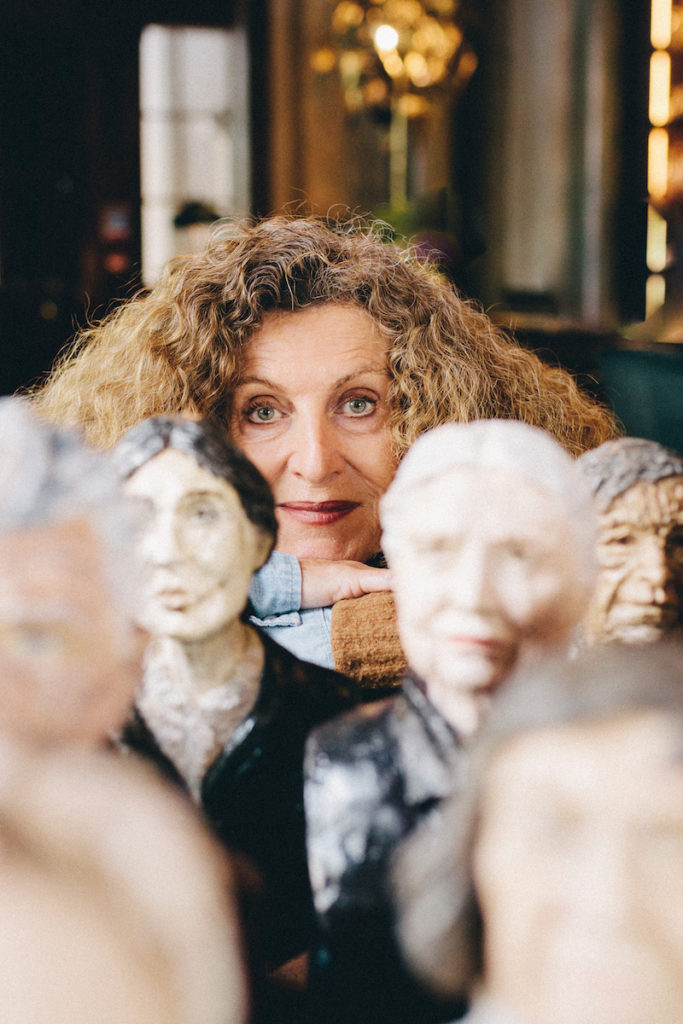Conversations at Scarfes Bar: Nicole Farhi
Charlotte Metcalf talks to Nicole Farhi for our August 'Conversations at Scarfes Bar' series
This post may contain affiliate links. Learn more
A chance encounter beneath a dining room table led Nicole Farhi to sculpture. Ahead of Nicole‘s ‘Writing Heads’ show in Edinburgh later this month, Charlotte Metcalf meets the artist and fashion designer, plus a few of her miniature heads…
Good things come in small packages
Nicole Farhi arrives with her curator Selina Skipworth, lugging a crate of sculpted heads. Protective of their fragility, Nicole wants to unwrap them herself, so I watch as ten recognisable writers’ faces – Hemingway, Beckett, Woolf and Lessing among others – emerge from their protective wrapping. Their expressions seem all the more intense because they are smaller than life-sized, as if their characters are concentrated and made extra vivid by compression. ‘They’re so amusing,’ smiles Nicole, lining them up on the piano. ‘It’s fun putting so much character into something small – sometimes miniatures can be more powerful.’
Nicole is, of course, a household name, known the world over for her eponymous fashion label. She became famous when she embarked on a partnership with Stephen Marks that led to French Connection, an intimate relationship and a daughter. ‘I was very lucky Stephen believed in me from the beginning, so I could do what I wanted,’ she says. ‘I designed things I wanted to wear – simple, soft, anonymous clothes in black, white or navy.’ Those loose, comfortable, well-cut, functional clothes attracted legions of devotees, who were dismayed when she gave it all up for sculpture, announcing she’d never loved fashion the way she loved art.
It all began with a cork…
‘Sculpture is something I do for myself, whereas fashion was always for someone else,’ Nicole explains. ‘Sculpture brought me freedom. About 35 years ago at a dinner, the woman next to me dropped a cork under the table and then disappeared after it. Eventually I peeked under the table and there she was, impeccably dressed, just sitting down there carving the cork. It sparked a conversation that changed my life as she introduced me to the abstract sculptor Jean Gibson who became my teacher. I studied three nights a week and Jean later said I was the most assiduous student she’d ever had. I’d still probably go to Jean’s studio if she hadn’t died in 1991.’
Nicole also met the artist Eduardo Paolozzi at the RCA’s foundry: ‘I was in my sexy phase and casting a piece called Orgasm that looked like an open egg with a flame coming out of it. Eduardo had such a sense of humour and was teased by the idea that here was this woman putting the patina on an erotic piece.’
A chance encounter
The chance meeting propelled Paolozzi and Nicole into a close and lasting friendship and Paolozzi was a witness at Nicole’s wedding to the writer David Hare in 1992. In her Hampstead home that Nicole now shares with David, Paolozzi’s sculpture and drawings are prominently displayed. She remembers Paolozzi with affection: ‘He was like a giant with a great big deep voice and huge hands but he could be so soft. You never forgot him. He taught me to sculpt whatever I wanted so long as it’s from the heart. So I sculpt exactly what I feel – about the lack of appreciation for large women, as in my last show Folds, or the lack of contact and love between people for my next show, Contact.’
Beauty everywhere
Folds, at the Beaux Arts Gallery in London earlier this year, showed work that was explicitly, frankly, voluptuously physical. One piece will stand in the foyer of an obstetrics and gynaecology hospital. ‘The woman who bought it said it looks like a woman just after she’s given birth, when the flesh is yielding, soft but so beautiful – I see beauty everywhere,’ says Nicole. She describes Contact, depicting women’s limbs and flesh entwined and embracing, as ‘all about getting back to the basics of touch through the hands’.
For Folds Nicole worked with two models, Paola Barone and Susan Tilley. ‘Sue had only ever sat for Lucian Freud but I persuaded her to come over – she wanted to see my portrait of Lucian,’ says Nicole. ‘The first thing I sculpted was Sue’s breast – she had no idea it could be so full of peace and beauty.’ Judging from the visceral sensuality of the work, Nicole delighted in the luscious layers of soft, thick, heavy flesh. ‘It was an antidote to the fashion industry,’ she says. ‘People were struck that I sculpted fragments rather than the whole body but I wanted to show that every breast, thigh, knee – even a foot can be beautiful. Once, in Hong Kong, I noticed how beautiful my assistant’s knees and elbows were – their perfect shape and round softness of articulation.’
Nicole sculpts in a conservatory that runs the length of the house, overlooking the garden: ‘David visits on Sunday mornings; if I want him to. He has a very good eye and I’m always interested in his views – he has lots to say about my literary heads. We understand each other and are proud of each other’s work. I’m love sculpting. When I don’t get dressed all day and can just be in my studio, in silent conversation with myself, I’m entirely happy. I loved working in fashion – I liked the speed of it and how everything changed so fast but I’ve done it, I’ve finished and turned the page. And now I’m happier as a person and so at peace.’
Nicole Farhi’s ‘Writing Heads’ will be showing from 25 July – 31 August 2019 at Fine Art Society, Edinburgh; edinburghartfestival.com
DISCOVER MORE INTERVIEWS:
Conversations at Scarfes Bar: Lynn Barber / In Conversation with Clare Milford Haven


